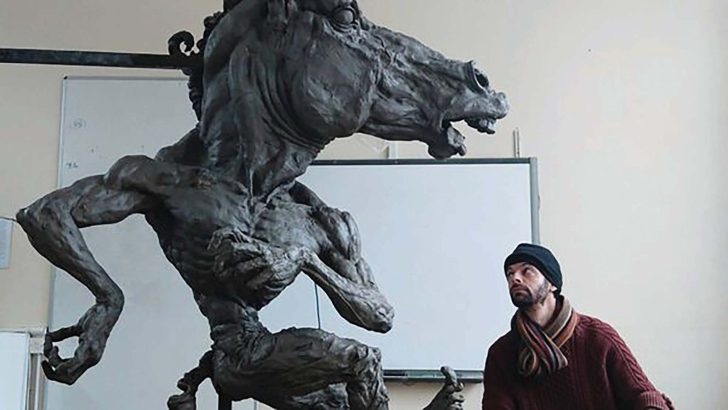by the books editor
The World of Books
The public fracas down in Ennistymon, Co. Clare over the erection of a statue representing the Púca of folklore has attracted a deal of amused comment around the country.
Certainly the affair focused the attention of the nation on aspects of our own modern Irish culture which deserve more serious attention than a few quick phone calls made by some journalists can provide. These are our attitudes to our folk tradition, and how we commemorate our political heroes and people who are much admired.
Clare County Council wished to erect a piece of modern sculpture, a worthy project, and indeed one to be admired. But on the way to fulfilment something went wrong. The maquette artist Mr Harte created and put forward, which was to cost some €30,000 to cast in bronze, was of the Púca (much of this money would go on the bronze and the fees of the foundry workers.)
In accounting for himself after the controversy broke out Aidan Harte said there was “nothing pagan” about his concept. This is an odd thing to say. He should have stuck to his original view that he was creating an image of a figure from our folklore past.
Problem
Why this should be a problem, I cannot understand. Humans have been on this island for some 300,000 years (the date is Prof. Frank Mitchell’s and I take from Dr Peter Harbison). If that seems unlikely, well 10,000 years ago is acceptable to most experts for Mesolithic humans. Some of the islanders have been Christian – or as in these days quasi-Christian – for only some 1,500 years. If we are to have nothing to do with our ‘pagan past’ we would have to ignore most of the human history of Ireland (which most people seem happy to do anyway).
No: the problem I have is not that the image is ‘pagan’, but that it takes a poorly thought out approach to the Púca. My mother in-law, who came from rural Co. Galway, taught my wife when she saw a snail in the garden, to say “Pooka, pooka, put out your horns.”
But for many others the pooka was something much larger, more akin to a small horse, a donkey, or a larger dog. This idea is based on what those who saw what they thought was a pooka in the first half of the last century — as recounted by Yeats’ close friend Dermot Mac Manus in his richly informative book The Middle Kingdom published back in 1959, an exploration through the words and experiences of named witnesses of “the faerie world of Ireland” in recent times; the real thing and not the faked up codology.
We have to remember that traditions of rural Ireland were not graphic but oral, the tale or the poem, and not the painting or drawing. It was American and British illustrators in Victorian times who created our all-too-common notions of the ‘gentry’. Aidan Harte draws upon this modern graphic genre and not on what was really believed in rural Ireland.
The second thing is the matter of public sculptures. Today these are decided upon by local authorities (‘the elected representatives’, so often evoked by ‘community workers’ in matters of controversy). Local people often feel they are little consulted.
Victorian days
It was very different in Victorian days. In Dublin the statues to Daniel O’Connell and Charles Stewart Parnell were not paid for by the corporation (as it was then) but by public subscriptions which a committee collected over a long number of years. The public voted with their cash, so we may take it that they were keen on the project.
But would this work now? As we all know, all too many people expect the Government or the councils to pay for these things without troubling us beyond our taxes. But if our Victorian forefathers had a strong say on what was imposed on them where they lived; different districts meant different heroes – hence the powerful image of Edward Carson in Stormont.
Maybe the present system is in the end more equitable and makes for less controversy, though here if there is a chance of a row we will seize it.
But this is a cultural matter that needs talking about from time to time.


 Peter Costello
Peter Costello Artist Aidan Harte with the maquette for his Púca statue.
Artist Aidan Harte with the maquette for his Púca statue. 